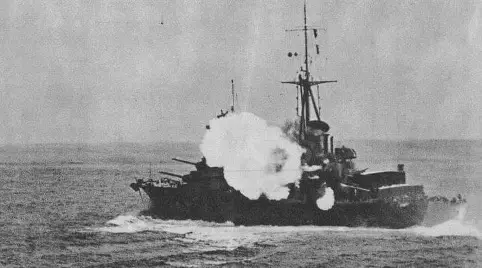Context
In June 1942, Malta was in a dire situation. Axis bombings had increased once again, thanks to the re-deployment of new Luftwaffe units in the theatre, reaching a peak in April-May. In addition, most of the convoys directed to the island in the first half of the year suffered severe losses, limiting the offensive capabilities of Malta. Last but not least, food reserves were approaching a critical level and the rations were already reduced. In this situation, the twin Operations Harpoon and Vigorous were launched, from Gibraltar and Alexandria respectively, aiming to bring relief to the sieged island. In a previous article, we talked about the twin operations in general, but here we will concentrate on a specific engagement between an Italian cruiser division (Admiral Da Zara) and the escort of the Harpoon convoy (Captain Hardy): the Battle of Pantelleria.
The encounter
In the night between the Harpoon convoy entered the Sicilian channel, passing nearby the Tunisian coast. The convoy consisted of the merchant ships Chant, Burdwan, Troilus, Orari and the tanker Kentucky. They were escorted by Force X, made by the AA cruiser Cairo (Hardy’s flagship), the 11th destroyer flotilla (Bedouin, Partridge, Marne, Matchless, Ithuriel), the 12th Destroyer flotilla (Blankney, Badsworth, Middleton, Kujawiak) and four minesweepers (Hebe, Speedy, Hythe, Rye).
At around 5:20 AM they were navigating 25 miles southwest of the Italian island of Pantelleria, with the merchants proceeding in two columns, with Cairo ahead, the minesweepers behind and the destroyers on the two sides. At that moment, they received a radio message from a friendly aircraft, signalling that two enemy cruisers were approaching from the north, being only 15 nautical miles far.
It was indeed Admiral Da Zara’s VII division, consisting of the cruisers Montecuccoli and Eugenio di Savoia, escorted by the X destroyer flotilla (Ascari, Oriani, Premuda) in a forward position and the XIV destroyer flotilla (Vivaldi and Malocello) behind.
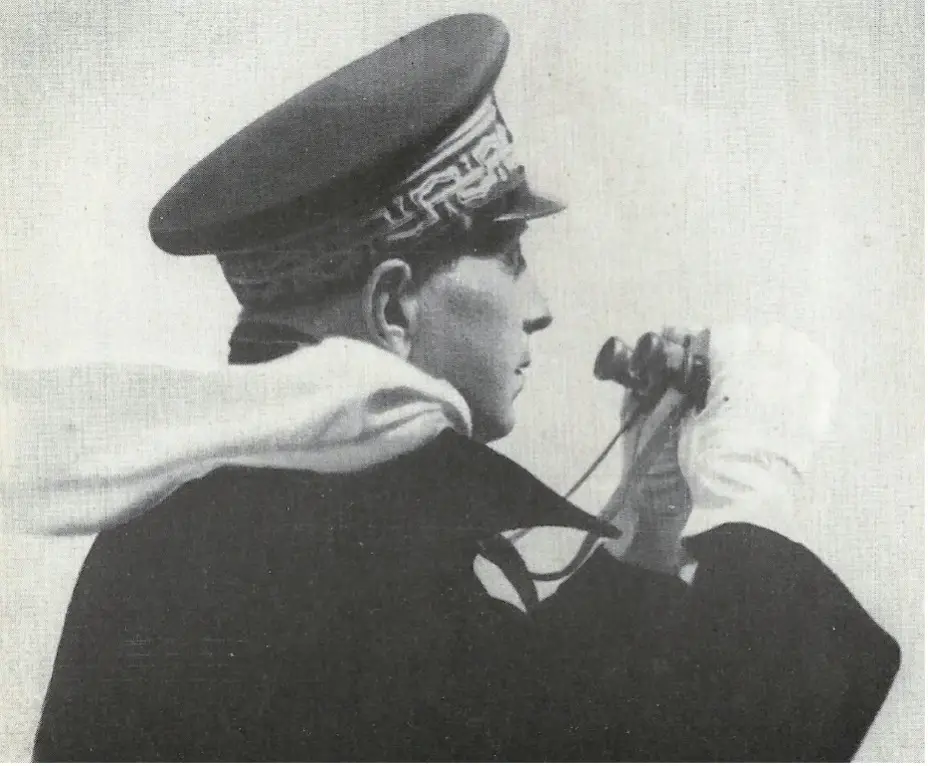
Admiral Da Zara
At around 5:30, when the first daylights appeared, the two formations sighted each other, and the battle began. The Italians were proceeding on a southern course, cutting the way to the allied formation, and navigating towards the southeast.
The battle
At 5:40 AM the opening salvos were fired by the Eugenio di Savoia against the Cairo, at approximately 16,000 meters, soon all the warships in the area participated in the fight. The slower Italian destroyers Malocello and Vivaldi were tasked to hunt the convoy and turned to their right, while Da Zara’s cruiser increased speed to 32knot, firing relentlessly on the enemy escort.
Cairo and the destroyers laid dense smokescreens to hide the convoy from the Italians and Hardy ordered the merchants to turn towards the Tunisian coast with the minesweepers. The two formations exchanged gunfire and torpedo attacks for around 1 hour while proceeding both on a southern course. Both Italian cruisers were lightly damaged but the British warships suffered more, with HMS Bedouin and Partridge badly hit and also Cairo with hits and flooding aboard.
Meanwhile, Vivaldi and Malocello tried to hunt down the merchants proceeding on a west-south-west course and exchanging fire with the destroyers of the 12th flotilla. Facing heavy enemy fire, the two Italian ships turned away at around 6:00 AM. While retreating, the Vivaldi received a hit in the forward engine room, leading the ship to a temporary halt and starting a fire. Commander Ignazio Castrogiovanni (commanding the XIV flotilla), ordered the Malocello to withdraw but instead, the sister ship laid smoke screens and kept defending the crippled Vivaldi. The two ships later managed to evade and leave the area.
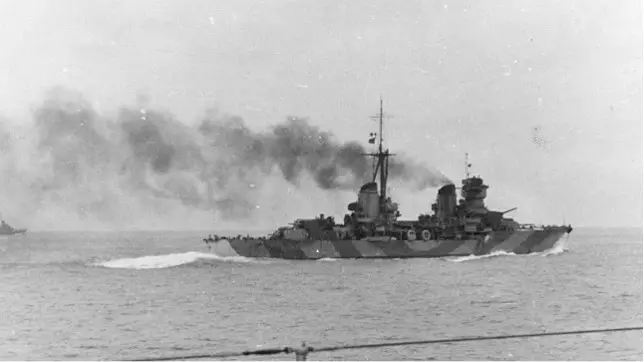
The cruiser Eugenio di Savoia
In the meantime, German Ju88 attacked the convoy. The merchant ship Chant was abandoned by the crew following an eruption of fire caused by a bomb hit. The ship was filled with fuel, coal and ammunition so the risk of an explosion was very concrete. The near miss of a German bomb severely damaged the engine of the tanker Kentucky, which was then towed by HMS Hebe.
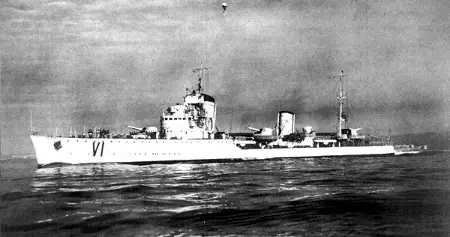
The destroyer Vivaldi
More to the south, the Italian cruisers had surpassed the British formation and kept firing, in some occasions the distance between the opposing ships came down to 6,000-7,000 meters, and also the 37mm AA guns of the Italian cruisers fired at their maximum range.
After an hour of relentless fight, Da Zara maneuvered to attack the British escort from the southwest, before turning to the north, hidden behind the smoke screen.
The Italian Admiral then set an eastward course, towards the southern end of a mine barrage. Da Zara expected to meet the British again at the northern end since this seemed to be the most obvious choice.
At around 8:30 with no enemy ships in sight, Captain Hardy maneuvered to reunite his formation with the merchant ships, in this phase he was slowed down by the reduced speed of the badly damaged Bedouin and Partridge. Kentucky was still towed by HMS Hebe and a subsequent air attack crippled the merchant Burdwan. At this point, Captain Hardy took the decision to scuttle Kentucky and the Burdwan and proceed towards Malta with the surviving ships. He was still quite far from his destination and with enemy ships in the area, he opted to save the rest of the convoy, sacrificing the slower and crippled ships.
Meanwhile, Da Zara had reached the northern end of the minefield but sighted no enemy ships, he later re-united with Ascari and Oriani and then proceeded southwest toward high columns of black smoke on the horizon (the Chant had exploded).
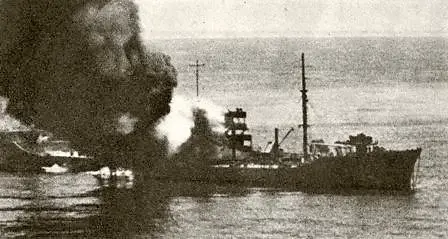
The tanker Kentucky in flames
At around 11:55, the Italians arrived in the area and sighted the burning wrecks of Kentucky, Chant, and Burdwan, but also the Partridge towing the Bedouin and the minesweepers. At 12:20 the Partridge left the towing and proceeded westwards, reaching Gibraltar some days later. Bedouin and Hebe received attention from the Italian cruisers and the Montecuccoli scored one of the longest hits in naval history (26,000 yards), damaging the little HMS Hebe. Soon, the crippled Bedouin received more hits from the Italian cruisers and was ultimately sunk later by an S.M.79 torpedo bomber. The Italians finished off the burning wrecks of Burdwan and Kentucky and around 14:20 set the course from home, the battle was over.

HMS Bedouin sinking
Epilogue
The Harpoon convoy ultimately arrived in Malta, with some ships further damaged by the explosion of small naval mines near the approach to the island. A few thousand tons of supplies were offloaded from the two surviving merchant ships. Very few in comparison to the 43.000 carried by the Harpoon convoy. Not counting the 50,000 of the Vigorous convoy never arrived.
With a decimated convoy, one destroyer sunk (Bedouin), another one badly damaged (Partridge), and the other three ships damaged (Cairo, Hebe and Ithuriel), the Italians (supported by German bombers) had won the battle.
The allies soon put in motion a huge re-supply operation to save Malta.
Sources
Fioravanzo, G. (1959). La Marina Italiana nella seconda guerra mondiale, Volume II La Guerra nel Mediterraneo: le azioni navali (Tomo 2). Roma: USMM.
O’Hara, V. P. (2022). Lotta per il Mare di Mezzo. Roma: Ufficio Storico della Marina Militare.
Da Zara, A. (2014). Pelle d’ammiraglio (Nuova edizione a cura di E. Cernuschi e A. Tirondola). USMM.
